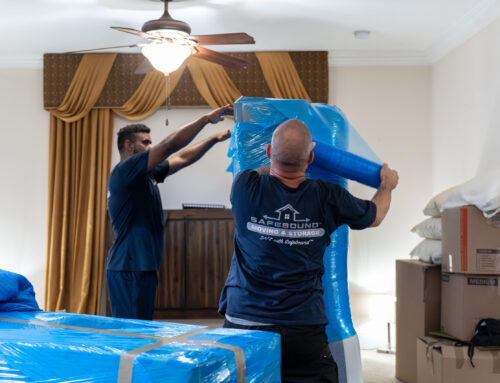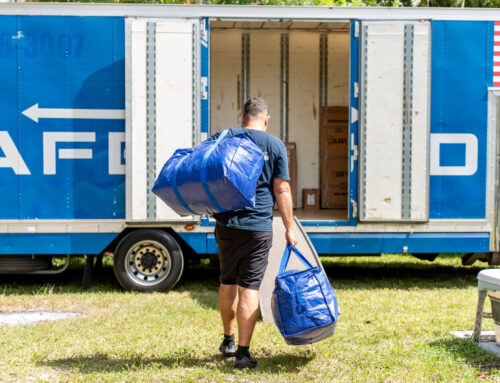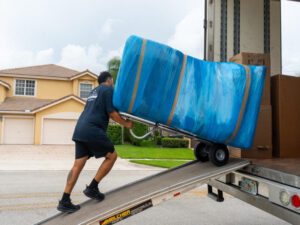
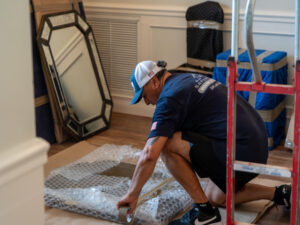
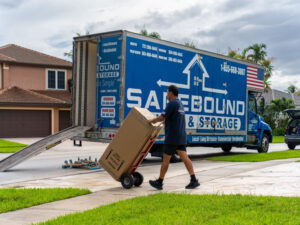
Moving is stressful enough without worrying about your belongings getting damaged. That’s why understanding moving insurance rates is so important. At Safebound Moving, we help you compare costs, coverage options, and protection levels so you can plan better and protect what matters most.
This guide explains what you’ll actually pay for different types of coverage, how moving insurance works, and the smartest ways to save money while keeping your valuables protected.
Basic Moving Coverage and Moving Insurance Rates Explained
First, you should know that standard moving coverage isn’t really “insurance.” It’s called valuation, and every moving company must offer two types by law.
- Released Value Protection – Costs nothing extra. However, it only covers $0.60 per pound, per item. If a 50-pound TV worth $1,500 is damaged, you’d only get $30. This option works if you’re moving items without much value.
- Full Value Protection – The mover repairs the item, replaces it, or pays you the current value. This coverage costs extra, which is where moving insurance rates become a factor.
You can read more about these options on Safebound’s Moving Damages & Coverage page. For background from the U.S. Department of Transportation, see the FMCSA’s guide to moving insurance: Protect Your Move – Moving Insurance.
Moving Insurance Rates: What Full Value Protection Costs
Full Value Protection typically costs 1% to 2% of your shipment’s total value. For household items worth $50,000, you’d pay between $500 and $1,000.
Several factors influence the exact rate:
- Distance matters. Local moves usually cost less than long-distance moves. A $30,000 local move might cost $300–$450 to insure, while the same items moved across states could cost $450–$600.
- Deductibles change the price. You can choose deductibles from $0 to $1,000. A zero-deductible plan costs more upfront but nothing at claim time. Picking a $500–$1,000 deductible can reduce premiums by 25–40%.
- Special items need extra coverage. Fine art, antiques, and jewelry typically require declarations and may have per-item caps (commonly $5,000–$10,000). Extra coverage often costs 3–5% of that item’s value.
Third-Party Moving Insurance Rates: Another Option
Beyond coverage from your moving company, you can also buy third-party moving insurance. These policies can cover more situations and sometimes cost less.
- Typical cost: $200–$800 for a household move (varies by shipment value, distance, and coverage scope).
- Coverage: Events standard valuation may not cover—like certain loading incidents, theft, and weather-related damage.
- When it makes sense: Long-distance moves, international moves, or when transporting valuable collections and family heirlooms.
What Affects Moving Insurance Rates
Understanding the levers behind moving insurance rates helps you budget more accurately:
- Value of your belongings. Higher declared value = higher premium, so inventory carefully and realistically.
- Packing method. Professionally packed items are less likely to be damaged, and some insurers offer 10–15% lower rates for pro-packed shipments.
- Season and distance. Summer peak season and long-distance moves can cost more to insure due to higher risk and more handling points.
- Home layout. Tight staircases, narrow doorways, elevators, and multi-floor homes can increase risk, which may impact rates.
- Claims history and mover reputation. Carriers price risk. Choosing reputable movers can help prevent claims—and sometimes keeps premiums in check.
How to Decide What Moving Insurance Rates Make Sense
Choosing the right coverage means balancing cost against risk:
- Make an inventory. Walk through each room, list items, and assign values. Most homes contain $25,000–$100,000 worth of goods.
- Identify irreplaceables. Heirlooms, art, instruments, and archives may need extra protection—or you might choose to move them yourself.
- Know your risk tolerance. If most items are replaceable, basic Full Value Protection may be enough. For antiques, collectibles, or custom pieces, opt for broader coverage.
- Check homeowners or renters insurance. Some policies cover a portion of belongings during moves (often limited). Always confirm with your insurer; the Insurance Information Institute offers helpful context: Moving and Insurance.
- Match coverage to move type. Local vs. long-distance vs. interstate/international all carry different risk profiles.
If you’re unsure where to start, compare options while you review Safebound’s services for local moves and long-distance moves.
How to File a Claim (Step-by-Step)
If something goes wrong, this simple process helps you get it resolved:
- Inspect on delivery day. Open boxes and check valuables while movers are still present when possible.
- Document immediately. Take photos or video of any damage, including packing materials and the box exterior.
- Locate your Bill of Lading. This shows your valuation choice and contract terms.
- File in writing. Submit your claim promptly (Safebound allows up to 9 months, but sooner is better).
- Work with claims support. Safebound guides you through repair, replacement, or reimbursement depending on your coverage.
- Keep records. Save estimates, receipts, and all correspondence until your claim is fully resolved.
You can start by reviewing Safebound’s Moving Damages & Coverage page, then contact our team for claim instructions.
Quick Checklist
- ✅ Choose Released Value or Full Value Protection before move day.
- ✅ Declare high-value items (and keep appraisals/receipts).
- ✅ Photograph belongings before movers arrive.
- ✅ Consider third-party insurance for long-distance or high-value shipments.
- ✅ File claims promptly if damage occurs.
Common Mistakes to Avoid
- Assuming everything is covered. Even Full Value Protection has limits and exclusions (e.g., normal wear and tear, some self-packed items).
- Hiring unlicensed movers. Verify licensing for interstate movers with the FMCSA (U.S. DOT).
- Not reading the fine print. Understand per-item caps, deductibles, and deadlines before moving day.
- Understating shipment value. Declaring less to “save” money reduces any eventual payout.
- Skipping documentation. Photos and inventories make claims smoother and faster.
FAQs
Do movers insure everything automatically?
No. Movers provide valuation, which is a defined level of liability. True “insurance” typically comes from a third-party policy.
Are moving insurance rates worth it?
If you’re moving electronics, antiques, instruments, or anything sentimental, the answer is usually yes. A small premium can prevent a big loss.
How much does Full Value Protection cost?
Plan on 1–2% of the declared shipment value. Deductibles, distance, and item types affect the final rate.
Can I combine mover coverage with third-party insurance?
Yes—and it often provides the most complete protection.
Does homeowners insurance cover a move?
Sometimes in limited ways. Always check with your carrier. For an overview, see the Insurance Information Institute: Moving and Insurance, and the FMCSA: Moving Insurance.
Safebound’s Recommendation on Moving Insurance Rates
At Safebound, we believe moving insurance rates are a small part of total moving costs but offer huge peace of mind. For most households, spending $500–$1,000 to protect $50,000–$75,000 in belongings makes sense—especially when you consider the stress and cost of replacing damaged items yourself.
- For local moves with typical furnishings, Full Value Protection is often the right fit.
- For long-distance moves or high-value shipments, third-party coverage may be the smarter choice for broader protection.
- For low-value, easy-to-replace items, Released Value Protection might be enough—just understand its limits.
Explore our local moves, long-distance moves, and learn about claims and options on our Moving Damages & Coverage page.
Final Thoughts
Your belongings represent years of hard work and priceless memories. Protecting them during one of life’s most stressful events is worth the modest investment. The right plan depends on your shipment, your risk tolerance, and your budget—but when you understand moving insurance rates, you can choose confidently.
Ready to compare coverage and get a clear plan? Contact Safebound Moving today for a free quote and move forward knowing your valuables are protected.


